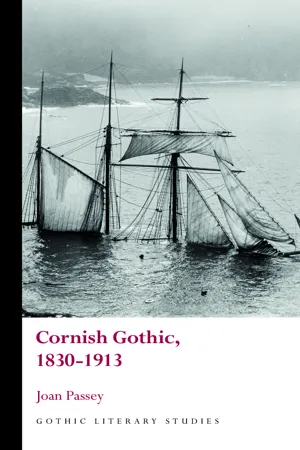
- 256 pages
- English
- ePUB (mobile friendly)
- Available on iOS & Android
Cornish Gothic, 1830-1913
About this book
This book asks why so many authors drew on Cornwall for inspiration across the long nineteenth century, and considers the seismic cultural changes in Cornwall that spurred this interest – from the collapse of the mining industry to the developing national rail network; from the birth of tourism to the neomedieval rise in interest in King Arthur. Understanding frequently overlooked Cornwall in this period is vital to understanding Gothic literature, the Victorian imagination, intellectual and creative networks, and attitudes towards regionality. The first part of the book considers landscape and legend, defining a mining Gothic tradition, exposing the shipwreck as Gothic mastertrope, and demonstrating how antiquarians drew from Cornish legends and lore. The second part explores encounters with modernity, investigating the impact of railway expansion on access to Cornwall, the development of a Cornish King Arthur as a key figure of Victorian masculinity, and the specific features of the Cornish ghost story.
Frequently asked questions
- Essential is ideal for learners and professionals who enjoy exploring a wide range of subjects. Access the Essential Library with 800,000+ trusted titles and best-sellers across business, personal growth, and the humanities. Includes unlimited reading time and Standard Read Aloud voice.
- Complete: Perfect for advanced learners and researchers needing full, unrestricted access. Unlock 1.4M+ books across hundreds of subjects, including academic and specialized titles. The Complete Plan also includes advanced features like Premium Read Aloud and Research Assistant.
Please note we cannot support devices running on iOS 13 and Android 7 or earlier. Learn more about using the app.
Information
Table of contents
- Cover
- Title Page
- Copyright Page
- Dedication
- Contents
- Acknowledgements
- Introduction: Corpses, Coasts and Carriages
- Part I: Landscapes and Legends: Preserving and Confronting the Past
- Part II: Travel and Tourism: Cornish Identity and Encounters with Modernity
- Conclusion
- Notes
- Bibliography